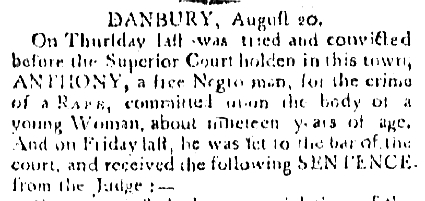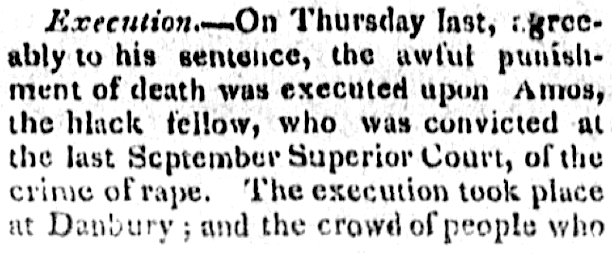By Kendra Baker
The only two public hangings in Danbury occurred in the late-eighteenth and early-nineteenth centuries. A product of heightened racial tensions in early America, both executions resulted in the death of a convicted black rapist. Reports of black-on-white rapes in post-Revolutionary America often focused on the “ruined innocence” of white women. This not only fueled the “myth of the black rapist,” but also helped structure rape prosecutions in early America. During this time the courts punished blacks more severely and with greater frequency than they did white offenders.
Danbury’s First Public Execution
The death of Anthony, a free black man from Greenwich, was Danbury’s first public execution. He was born to a free black woman on Long Island in 1773 and began working to support his family at the age of 12. He later moved to Greenwich, got married, and had a daughter. Anthony—authorities only referred to him by this one name—had never been to school or church. He had no record of getting in trouble with the law, but he often enjoyed drinking in his spare time.

Detail from an article titled “Danbury, August 20” published in the Connecticut Gazette, New London, Connecticut, September 5, 1798.
A drunken Anthony returned home the night of March 7, 1798, and found a white woman named Mary Knapp near his door. It is unknown if the two knew each other or arranged to meet there. The next morning, authorities arrested Anthony for rape and threw him in Danbury’s jail. Five months later, the Danbury Superior Court sentenced Anthony to death. He appealed for a communication to life, but the state assembly denied his request.
On November 8, 1799, authorities removed Anthony from the jail and took him to the crowded Congregational church. Anthony sat in the front and listened to Rev. Timothy Langdon read the thirty-fifth and thirty-sixth verses of the thirty-second chapter of Deuteronomy. The reverend said Anthony’s situation was “truly deplorable” and exhorted him to repent, look to Christ, and die “in a Christian temper.”
After church, civil authorities took Anthony to the gallows erected on the Elm Street property of Samuel Dibble. A crowd of people gathered, some of whom even donated ropes and materials for the hanging. Sheriff Dimon read the execution warrant for Anthony, announcing he was “to be hanged up by his neck between the heaven and the earth until he shall be dead.” Anthony had no final words and did not protest. He was only about twenty-five years old. After his death, the site of his execution became known as “Gallows Hill.”
The Hanging of Amos Adams
Danbury’s second execution was of a black Greenwich man named Amos Adams. Authorities convicted Adams of raping Lelea Thorp, a married white woman and mother, in her Weston home the night of August 29, 1817. A grand jury indicted Adams and he pleaded not guilty. An all-male jury found Adams guilty in September and sentenced him to hang on November 13, 1817.
The morning of his execution, military guards removed Adams from jail and marched him to the Congregational church. Adams sat in a pew with “a halter around his neck” as Rev. William Andrews gave a sermon at the crowded church. After the service, a procession marched Adams up West Street to a scaffold erected at the intersection of what is now Elm and Beaver Streets.

Detail of Amos Adams’ execution from an article in the Connecticut Journal, New Haven, Connecticut, November 25, 1817.
There was an immense crowd gathered for the execution. Some of the spectators arrived in Danbury early in the morning, but others actually came the night before. They purchased refreshments from stands set up at the site and some climbed trees to get a better view of the hanging. With the cutting of a rope, the twenty-eight-year-old Adams became the last person executed in Connecticut for a capital crime other than homicide.
Danbury is a city that takes pride in its diversity, including serving as a home to iconic 20th-century African American singer Marian Anderson. As recently as 2007, the city erected a monument in Wooster Cemetery in honor of its black Civil War soldiers. But many of its residents remain unaware of the executions of Anthony and Adams and the social ramifications of their deaths. An acknowledgment of these stories recognizes that even the darkest histories are important to remember for the perspective they provide about who we are today.
Kendra Baker is a reporter for the Wilton Bulletin and a lifelong Danbury resident.









